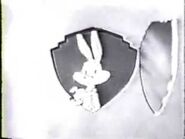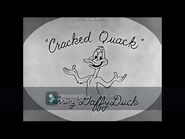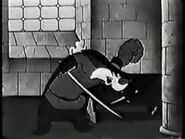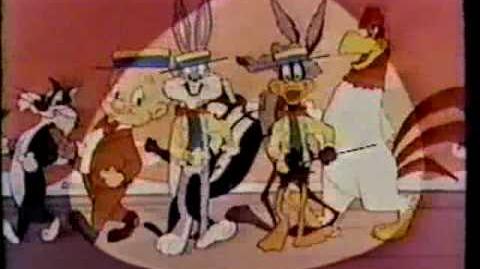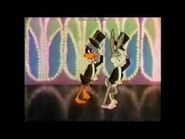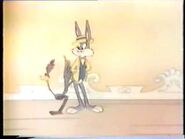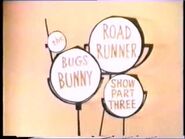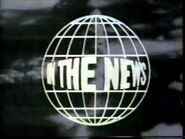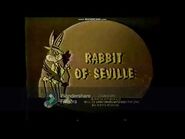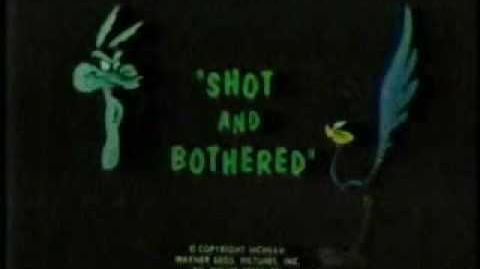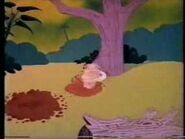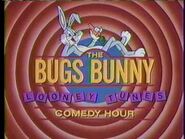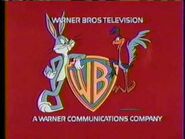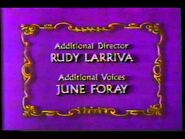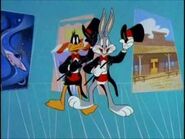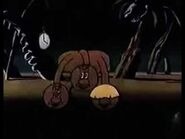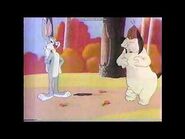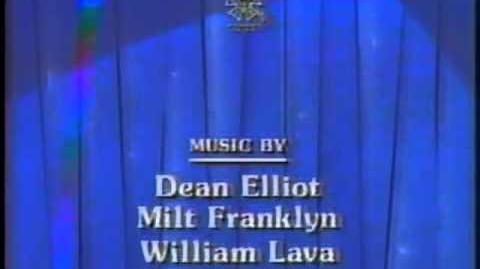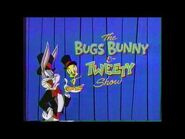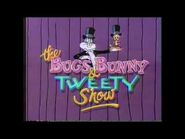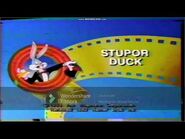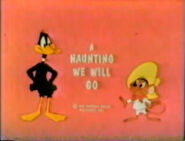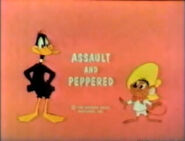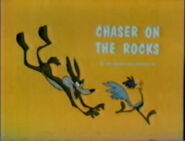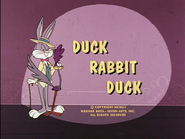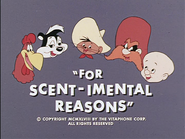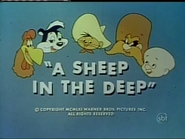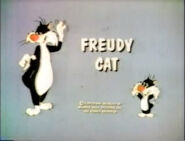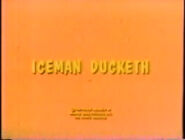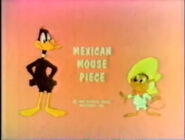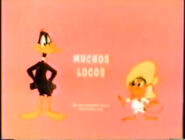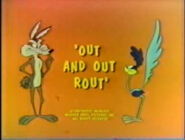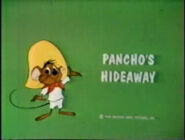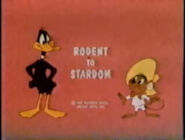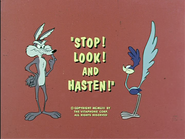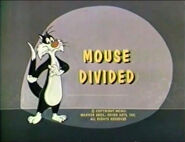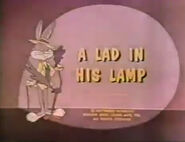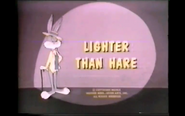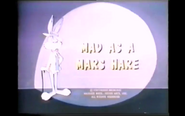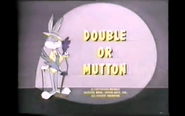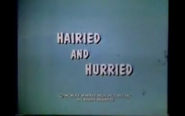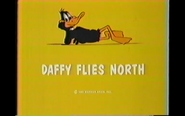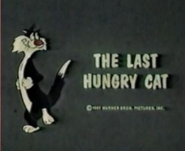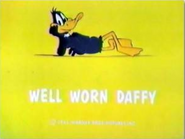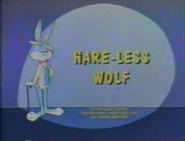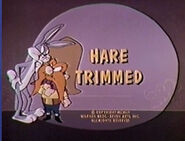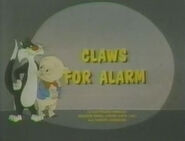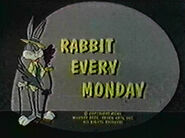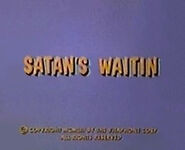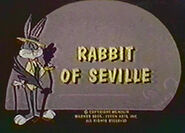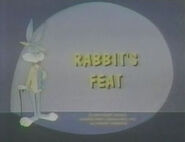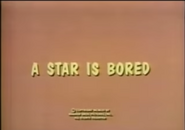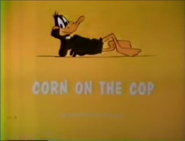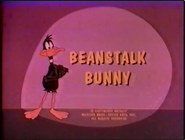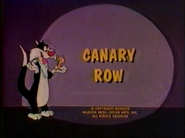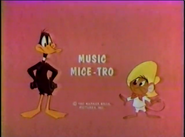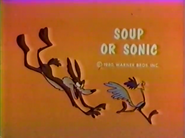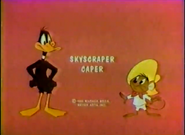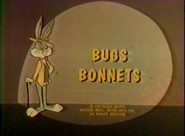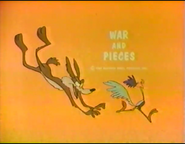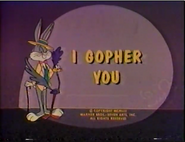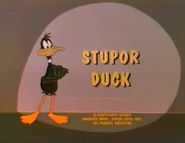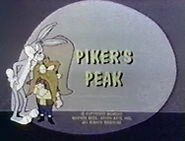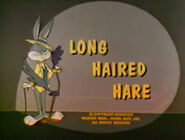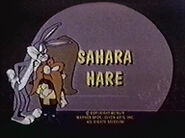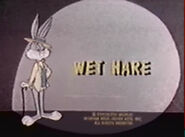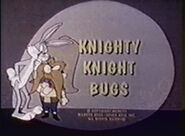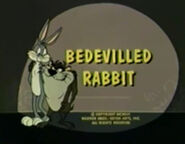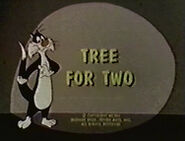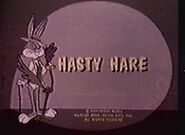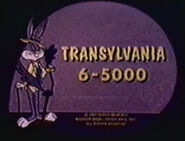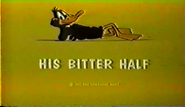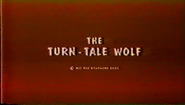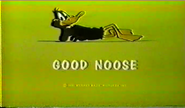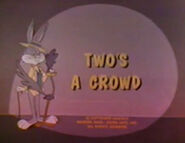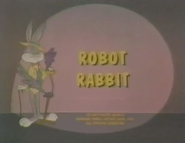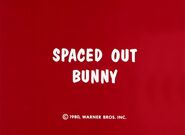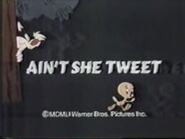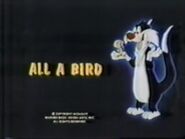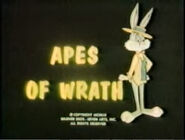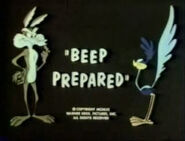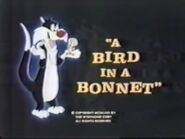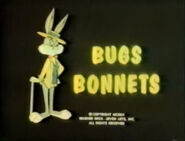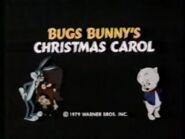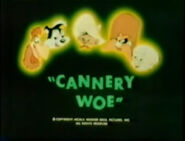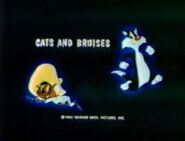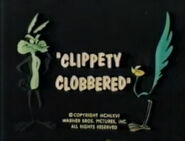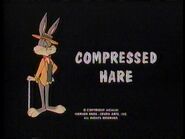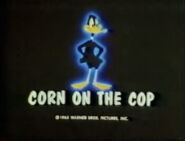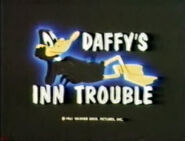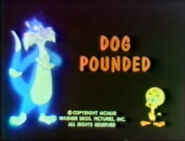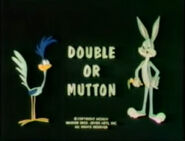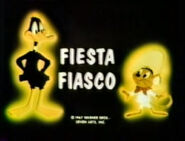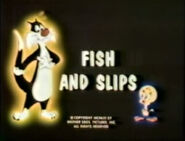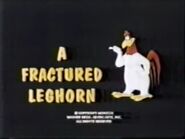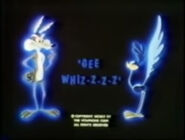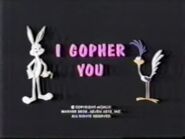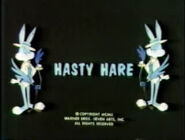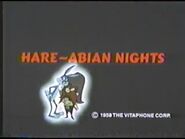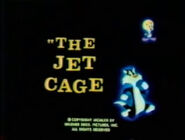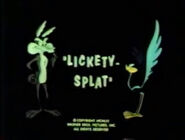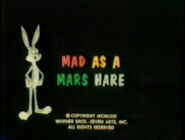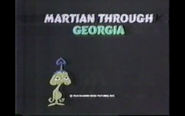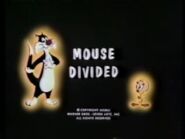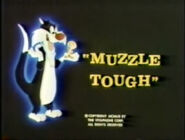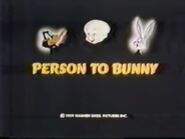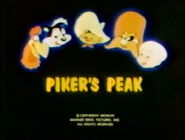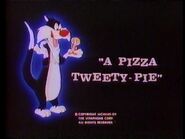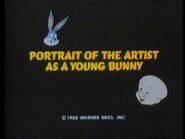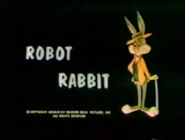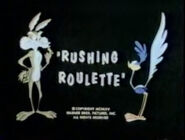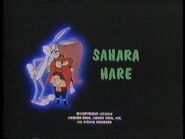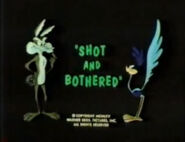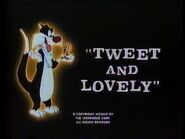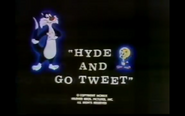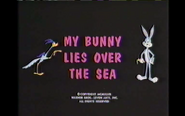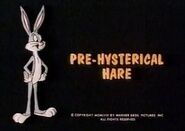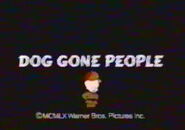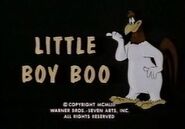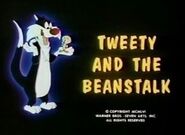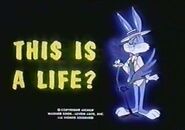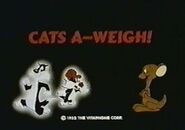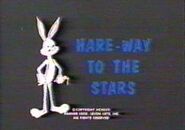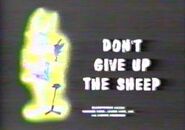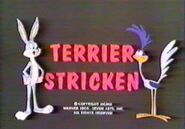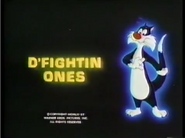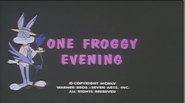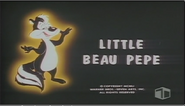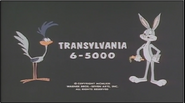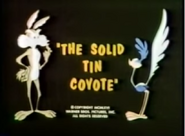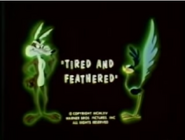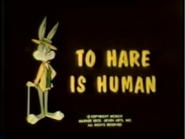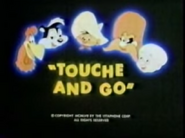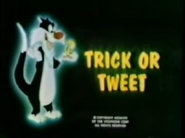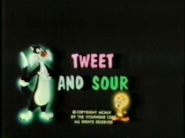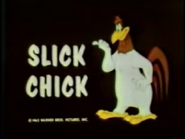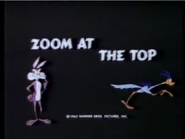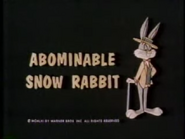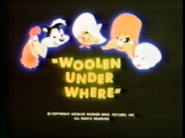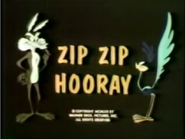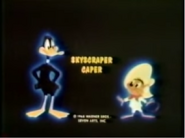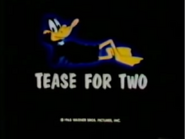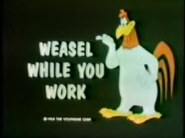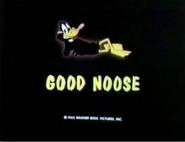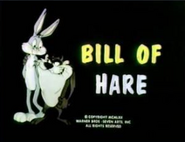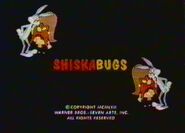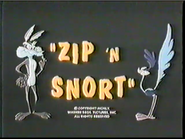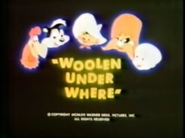The Bugs Bunny Show is a long-running American television anthology series hosted by Bugs Bunny, that was mainly composed of Looney Tunes and Merrie Melodies cartoons released by Warner Bros. Because some of the copyrights, but not the original negatives, were sold to Associated Artists Productions in 1956 and the TV distribution rights to all the black-and-white Looney Tunes and some black-and-white Merrie Melodies were held by other companies until 1969, the show only could air cartoons released starting with "You Were Never Duckier."
The show originally debuted as a primetime half-hour program on ABC in 1960, featuring three theatrical Warner Bros. cartoons with new linking sequences produced by the Warner Bros. Cartoons staff.
After three seasons, The Bugs Bunny Show moved to Saturday mornings, where it remained in one format or another for nearly four decades. The show's title and length changed regularly over the years, as did the network: both ABC and CBS broadcast versions of The Bugs Bunny Show, as did Canadian network CBC Television (1969-1975) and local Canadian stations via syndication (1975-early 1980s).[1] In 2000, the series, by then known as The Bugs Bunny & Tweety Show, was canceled after the Looney Tunes and Merrie Melodies libraries became the exclusive property of the Cartoon Network family of cable TV networks.
Unlike The Porky Pig Show or The Road Runner Show, not every episode featured a Bugs Bunny cartoon.
Broadcast and Format History[]
Prime Time, 1960-1962[]
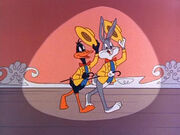
Bugs and Daffy.
The original Bugs Bunny Show debuted 11 October 1960 on ABC prime time, airing on Tuesdays at 7:30 PM EST, under the sponsorship of General Foods (Post cereals, Tang, etc.). Newly produced linking segments were done for each episode by the Warner Bros. animation staff. Chuck Jones and Friz Freleng produced, directed, and created the storyboards for the earliest of these, with Robert McKimson later taking over the direction while Jones and Freleng continued producing and writing.[2] The wraparounds were produced in color, although the original broadcasts of the show were in black-and-white.
The show's theme song was "This Is It", written by Mack David and Jerry Livingston ("Overture/curtain, lights/this is it/the night of nights..."). The opening title sequence, animated by Freleng unit animator Gerry Chiniquy,[3] features Bugs and Daffy Duck performing the song in unison. For the final chorus, a lineup of Looney Tunes characters joins Bugs and Daffy onstage (Porky Pig and Road Runner, however, are absent from the procession).
The Bugs Bunny Show proved beneficial to the Warner Bros. staff, as it allowed the studio to remain open despite the shrinking market for theatrical animated shorts.[4] The final first-run episode of the original Bugs Bunny Show aired 7 August 1962,[5] and the Warner Bros. animation studio closed the following spring.[4]
Saturday Mornings and Switch from ABC to CBS, 1962 – 1985[]
ABC began re-running The Bugs Bunny Show on Saturday mornings in August 1962. The series was rerun in color beginning in 1965, and remained on ABC until September 1968. At this point, the series switched to CBS, where it was combined with The Road Runner Show (which had aired on CBS since 1966) to create The Bugs Bunny/Road Runner Hour.[6] The standard Bugs Bunny Show opening and the announcer's introduction of Bugs Bunny ("that Oscar winning rabbit!") were directly followed by the rabbit's saying, "...and also starring my fast feathered friend, the Road Runner", after which The Road Runner Show's theme was played. The Bugs Bunny/Road Runner Hour combined re-edited bridging sequences from both shows to link the seven cartoons featured in each episode. The bridging sequences would be edited further in later versions of the Bugs Bunny/Road Runner Hour.[7]
In 1971, The Road Runner Show moved to ABC, and a reconstituted half-hour Bugs Bunny Show aired on CBS, featuring re-edited versions of the bridging sequences and a different grouping of cartoons.[6] In 1973, The Bugs Bunny Show returned to ABC for two seasons, only for CBS to re-acquire both shows and bring back The Bugs Bunny/Road Runner Hour in 1975.[6] In 1976, Sylvester and Tweety were featured in their own Sylvester and Tweety show for one year, necessitating the removal of most of the Tweety and/or Sylvester cartoons on Bugs Bunny/Road Runner that season. Also that year, a weekly half-hour prime-time edition of The Bugs Bunny/Road Runner Show briefly aired on CBS' Tuesday night schedule from April through June.
The Bugs Bunny/Road Runner Hour became The Bugs Bunny/Road Runner Show in 1977 after CBS added another half-hour to the runtime. In 1981, a companion Sylvester & Tweety, Daffy, and Speedy Show was added to the CBS schedule, which included a number of later cartoons produced by a reestablished Warner Bros. Cartoons studio from 1967 to 1969. The following year, this new companion series was canceled, and its cartoons were incorporated into the The Bugs Bunny/Road Runner Show, which was broadcast as two separate hour-long programs on Saturday mornings; the second show featured a newly reanimated title sequence. During the final chorus when a lineup of Looney Tunes characters joins Bugs and Daffy onstage, Speedy Gonzales is replaced by Sylvester Junior, and Pepé Le Pew is replaced by the Road Runner. The Road Runner portion of the intro also used a new selection of clips.[6] In 1983, CBS returned the show to 90 minutes, and the bridging sequences were dropped, though the intermission bumpers remained to some degree.[8] The following year, the "This Is It" opening was jettisoned altogether; a new title sequence (created from clips of the cartoons and Looney, Looney, Looney Bugs Bunny Movie) and new theme song ("It's Cartoon Gold"), composed by Steve Zuckerman with lyrics by John Klawitter, introduced the show.[6]
Final Years on ABC, 1985 – 2000[]
CBS gave up the rights to broadcast the Warner Bros. cartoons following the 1984-85 season, and as a result, the show moved back to ABC, where it became The Bugs Bunny/Looney Tunes Comedy Hour. Cartoons featuring Tweety or Speedy Gonzales were not broadcast on ABC during the 1985–86 season. The following year, however, Tweety cartoons were added to the program, which was reduced to a half-hour and renamed The Bugs Bunny & Tweety Show.[9]
Beginning with its third season, The Bugs Bunny & Tweety Show was expanded to a full hour, and the original "This Is It" theme was reintroduced, accompanied by the 1983 introductory sequence.[9] Another version of the "This Is It" opening sequence was redone in 1992, this time with higher quality animation, with Hippety Hopper being removed and Pepé Le Pew and Porky Pig being added behind Yosemite Sam in the procession at the final chorus.[10]
In 1996, ABC became a subsidiary of The Walt Disney Company following the Disney studio's acquisition of Capital Cities/ABC Inc. that year, hence between 1996 to 2000 the program was one of the very few non-Disney television programs to air on the network at the time. Though the program did not qualify for the educational/informational designation, it nonetheless remained on Saturday mornings after the new designation debuted in 1996, one of the few non-E/I programs to survive the rules changes. The program was often paired with ABC's in-house Schoolhouse Rock! shorts during this time.
The hour-long Bugs Bunny & Tweety Show remained on the air until 2000, when it was again reduced to a half hour. In 2000, Warner Bros. made the Looney Tunes and Merrie Melodies film library exclusive to Cartoon Network, as it is part of the same corporate ownership. As a result, The Bugs Bunny Show ended its four-decade-long network run 2 September 2000 with the shorts The Grey Hounded Hare, Tugboat Granny, and Guided Muscle, ending one of the longest runs in the history of American network television.[9]
List of Formats[]
- The Bugs Bunny Show, 11 October 1960 – 8 September 1968 (ABC)
- (in color starting 10 September 1966)
- The Bugs Bunny/Road Runner Hour, 14 September 1968 – 4 September 1971 (CBS)
- The Bugs Bunny Show, 11 September 1971 – 1 September 1973 (CBS)
- The Bugs Bunny Show, 8 September 1973 - 30 August 1975 (ABC)
- The Bugs Bunny/Road Runner Hour, 6 September 1975 – 12 November 1977 (CBS)
- The Bugs Bunny/Road Runner Show, 19 November 1977 – 7 September 1985 (CBS)
- The Bugs Bunny/Looney Tunes Comedy Hour, 7 September 1985 – 6 September 1986 (ABC)
- The Bugs Bunny & Tweety Show, 13 September 1986 – 2 September 2000 (ABC)
Episodes[]
See The Bugs Bunny Show Episodes
Legacy[]
This show is credited for keeping the Warner Bros. cartoons made during the Golden Age of American animation a part of the American consciousness. Indeed, the show ran for more than four decades, and helped inspire animators, comedians, historians, and others who watched Saturday morning television.[11] The "This Is It" song's fame is such that it has been used elsewhere such as in the Canadian province of Ontario where it was used in a TV commercial promoting the various performing arts tourist attractions where artists of various disciplines sing separate lines of the song.
When Warner Bros. released its video series Golden Jubilee, featuring the classic cartoons, the opening sequence shows the Tasmanian Devil maniacally riding a motorcycle down a city street, chased by a police car. He makes a sharp turn into a theater, where the rest of the Looney Tunes are performing to the Bugs Bunny Show tune.

The color version of the show's title card from Episode 23, as seen on the Saturday Morning Cartoons: 1960s Vol. 2 DVD.
Title sequences and some linking material from the original Bugs Bunny Show are included as bonus features on each volume of the Looney Tunes Golden Collection DVD collection. As the original color negatives were cut up by CBS and ABC to create later versions of the show, the linking sequences are presented on DVD using a combination of footage from both what is left of the color negatives (some of which were used in later incarnations, thus helping to preserve them) and the black-and-white ABC broadcast prints prepared in the early 1960s.
However, there is one rather unimpeachable voice who says that the shows do exist in complete form. Jerry Beck (who has done extensive research in the Warner Bros. cartoons) states that copies of the show are not lost; in fact, black-and-white negatives of all episodes are in the possession of Warner Bros. (and color negatives may exist in Europe).[12] He has been instrumental in the release of bridging material on the Golden Collection DVDs. For reasons such as the financial incentive of reassembling the negatives and broadcast prints of the remaining episodes however,[13] Warner Bros. is withholding the episodes for the time being; the decision to restore the series and release to the public entirely rests on them.
Availability[]
Episode 23 has been released on Saturday Morning Cartoons: 1960's Volume 2 DVD release.
Censorship[]
- Main article: The Bugs Bunny Show Censorship
ABC and CBS heavily cut their cartoons in these Bugs Bunny Show incarnations, often for content, moreso than any other television network in the United States.
ABC's edits were done to remove violence that goes beyond normal slapstick, scenes featuring racially insensitive caricatures (mostly Native Americans, Asians, Latinos, and African-Americans, though ABC cut the end of the Sylvester and Tweety short "Trip for Tat" because it had Sylvester speaking in a faux Italian accent and eating spaghetti, claiming that Italians are fat because they eat large servings of spaghetti), and any scene containing dangerous, imitable behavior, often cigarette smoking, alcoholic drinking, fooling around with electricity, ingesting dangerous chemicals, any scenes involving suicidal actions, running into industrious streets, and getting locked or trapped in appliances or trunks, to name a few examples. ABC also cut scenes from Looney Tunes cartoons that were not only violent or considered racially insensitive, but also may be offensive to those with speech impediments, like the "A thousand a-ble-a-ble bucks" stuttering gag in "Dog Collared", or mental illness, like the "Fruitcake Sanitarium: It's Full of Nuts" sight gag in "Hare Brush" and Daffy thinking the possessed Melissa Duck is a schizophrenic, calling her "Sybil", and asking her if she can conjure up her "older sister" personality in "The Duxorcist".
In contrast to ABC, CBS merely focused on edits for violence and dangerous, imitable behavior, though the channel also edited out drug references, such as Sylvester chain-smoking cigarettes and drinking coffee on "The Last Hungry Cat", Bugs blowing cigar smoke in Elmer's face on "Bugs' Bonnets", Elmer using a cigarette to smoke Bugs and Daffy out of his head on "Beanstalk Bunny", Daffy pouring sleeping powder in the guard dog's water dish in "Fast Buck Duck", and a mouse eating muscle-building vitamins to beat up Sylvester on "Cats A-weigh!".
In both cases, the edits done to these cartoons often caused plot-holes or ruined jokes by cutting either the set-up, the punchline, or both. CBS' edits were particularly careless because they directly spliced the 16mm films to remove the offending content, whereas ABC transferred the cartoons to videotape so they could do edits more seamlessly, though even ABC's edits could be careless and obvious at times. Sometimes, both networks would edit the same cartoon (sometimes for different reasons). Other times, one cartoon would be edited on ABC, but not on CBS, and vice-versa.
Both Bugs Bunny Show incarnations also edited the original opening and closing credits of all the cartoons aired, presumably due to rights issues. Consequently cartoons with gags that involve either the opening or closing credits sequence, such as "Stop! Look! And Hasten!", "Beep Prepared", "Box Office Bunny", "Whoa, Be-Gone!", "Boyhood Daze", "Fastest with the Mostest", and "Transylvania 6-5000", have these gags cut.
Videos[]
Title Cards[]
The Bugs Bunny/Road Runner Hour/The Bugs Bunny/Road Runner Show[]
The Bugs Bunny/Road Runner Show (Final Season)/The Bugs Bunny and Tweety Show (First Season)[]
International Broadcasts[]
- It aired on Toggo from Super RTL in Germany.
- In 1990, Nine Network Australia began airing their own Looney Tunes compilation show entitled The Bugs Bunny Show. It featured the same opening but instead of being "hosted" by Bugs Bunny like in the 1960s season, it was hosted by a human (Sophie Lee) and had prize giveaways and interviews with celebrities.[14][15][16] After its cancellation in 1992, it was later succeeded by a similar Looney Tunes compilation show What's Up, Doc? hosted by a variety of presenters including Catriona Rountree and Kate Fisher which ran from 1992-1999[17][18][19][20], only to be succeeded by the short-lived Looney Tunes compilation show The Looney Tunes Show hosted by Holly Brisley in 2002.[21]
- Another show that's related to The Bugs Bunny Show that was aired in the UK was "What's Up Doc?" that was aired on ITV during Saturday Mornings from 1992 until 1995, that hosted by Andy Crane, Yvette Fielding and Pat Sharp with Jenny Powell replaced Fielding for the latter part of the final series, the show itself was produced from TVS from 1992 and Scottish Television from January 1993 until 1995, the puppet segments of the show contains 2 of the twin wolves known as "Bro and Bro," created by Jim Henson's Creature Shop and were portrayed by Don Austen and John Eccleston, unlike The Bugs Bunny Show, it also features some other shows such as Animaniacs, Batman: The Animated Series, and Taz-Mania.[2]
References[]
- ↑ https://kevinmccorrytv.ca/bbrr.html
- ↑ Maltin, Leonard (1980, rev. 1987). Of Mice and Magic: A History of American Animated Cartoons. New York: Plume/Penguin Books. Pg. 274–275.
- ↑ McCorry, Kevin (2007). "The Bugs Bunny Show Page." Retrieved May 17, 2017.
- ↑ 4.0 4.1 Barrier, Michael (1999). Hollywood Cartoons: American Animation in its Golden Age. New York: Oxford University Press. Pg. 562. ISBN 0-19-516729-5.
- ↑ The Bugs Bunny Show: A Tale of Two Kitties – TV.com
- ↑ 6.0 6.1 6.2 6.3 6.4 McCorry, Kevin (2007). "The Bugs Bunny/Road Runner Hour Page." Retrieved 17 May 2017.
- ↑ Beck, Jerry and Will Friedwald, Looney Tunes and Merrie Melodies: The Complete Illustrated Guide to the Warner Bros. Cartoons, Henry Holt, 1989
- ↑ https://www.youtube.com/watch?v=o_aGE7w6Fs0
- ↑ 9.0 9.1 9.2 McCorry, Kevin (2007). "The Bugs Bunny/Tweety Show Page." Retrieved 17 May 2017.
- ↑ https://www.youtube.com/watch?v=RW8f2tFPjyE&ab_channel=Originalaudiocartoons
- ↑ "Looney Tunes on Television", a website dedicated to the Looney Tunes television broadcast history, and maintained by Kevin McCorry and Jon Cooke. (archived)
- ↑ [1], which discusses the preservation of "The Bugs Bunny Show"
- ↑ https://cartoonresearch.com/index.php/wanted-the-bugs-bunny-show-2/
- ↑ https://www.youtube.com/watch?v=7LmvnsGnqJQ&ab_channel=AusVHSarchive
- ↑ https://www.youtube.com/watch?v=WFAIs2RMAtc&ab_channel=AusVHSarchive
- ↑ https://www.youtube.com/watch?v=fJKivIsBKfA&ab_channel=AusVHSarchive
- ↑ https://www.youtube.com/watch?v=OnlARwjtm8E&ab_channel=xenclips
- ↑ https://www.youtube.com/watch?v=HzPLzDLkzrU&ab_channel=DanceMusicAustralia
- ↑ https://www.youtube.com/watch?v=xd_pHc-FooU&ab_channel=8BigKids
- ↑ https://www.youtube.com/watch?v=QKsNKdjJqIE&ab_channel=xenclips
- ↑ https://www.youtube.com/watch?v=OqlRXUOaXmg&t=3s&ab_channel=EyewitnessTV


